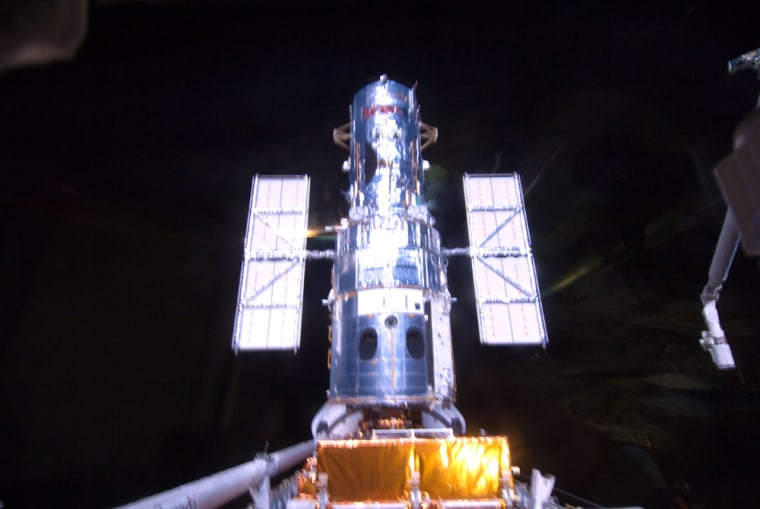A rejuvenated Hubble Space Telescope, more powerful than ever, departed the space shuttle Tuesday and sailed off for new discoveries.
“It’s showtime for us now,” said program scientist Eric Smith.
Hubble — considered to be at its prime following five days of repairs and upgrades — was gently dropped overboard by the shuttle Atlantis astronauts, the last humans to see the 19-year-old observatory up close.
It was NASA’s last service call and, despite spacewalking moments ranging from anguish to elation, turned out to be “a 110 percent successful mission,” said senior project scientist David Leckrone.
“Today begins the second Hubble revolution,” an emotional Leckrone said from Houston.
Smith happily ticked off a few of Hubble’s early accomplishments: determining the age of the universe, finding dark matter, studying planets around other stars. “Now it’s even better. I am really looking forward to what comes next,” he said.
The shuttle and telescope had just crossed the Atlantic, and were soaring 350 miles (560 kilometers) above the coast of northwestern Africa, when robot arm operator Megan McArthur set Hubble free. Then the shuttle slowly backed away.
‘Incredible journey’
“It’s safely back on its journey of exploration as we begin steps to conclude ours,” radioed commander Scott Altman. “Looking back on this mission, it’s been an incredible journey for us as well.”
With Hubble flying on its own again, the seven astronauts looked ahead to Friday’s planned landing. But first they had to inspect their ship one last time to make sure it had not suffered any serious damage from space junk. The wing and nose survey, similar to one performed last week to check for launch damage, consumed their afternoon. Altman said the crew saw nothing to be concerned about, but experts on the ground were still analyzing the imagery Tuesday night.
The telescope’s unusually high orbit had placed the shuttle and its crew at increased risk and, because of the lack of a refuge, prompted NASA to keep a rescue ship on standby until the end of the 11-day flight. To improve their safety, the astronauts dropped Atlantis into an egg-shaped orbit that is, much of the time, lower than the telescope’s junk-ridden orbit.
Spacewalks loaded with drama
During five consecutive days of spacewalks loaded with drama, Atlantis’ crew labored tirelessly on the observatory. Four men working in teams of two gave the telescope two new high-powered science instruments and a suite of other up-to-date equipment, and fixed two broken instruments, something never before attempted in orbit.
The astronauts persevered, despite stuck bolts, ill-fitting gyroscopes and flyaway shreds of insulation. Two of them were ready to jump into spacewalking action one last time if a last-minute problem had cropped up Tuesday morning. None did.
At a news briefing, flight director Tony Ceccacci noted there were those “who thought we couldn’t do this.”
“They always told us, ’you’re too aggressive, you’re going to get in trouble,”’ he said. “I don’t want to say we told you so, but we told you so.”
The Hubble team hopes to resume celestial observations by the end of summer.
First image will show star cluster
At the end of this month, the improved Hubble will take its first pictures, but only to make sure its instruments are working. The image will be a well-studied cluster of stars in the constellation Sagittarius that go by the boring name NGC6681. Astronomers have known about this group of stars for nearly 230 years. It is about 29,000 light years away.
Astronomers expect to get another five to 10 years of use out of the iconic telescope, thanks to the astronauts’ extraordinary effort.
As for Hubble’s future after that, there will be no more visits. Sometime after 2020, NASA will send a robotic craft to steer it back into the atmosphere and a watery grave. The spacewalkers installed a docking ring for just that purpose.
AP's Seth Borenstein contributed to this report from Houston.
More on Hubble | Space shuttle
